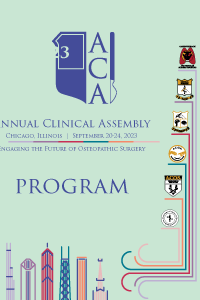Urological Surgery
The Impact of Low Pressure Pneumoperitoneum in Robotic Assisted Radical Prostatectomy II: A Prospective, Randomized, Double Blinded Trial
- RE
Richard Eames, D.O.
University of Michigan Health - West
Wyoming, Michigan, United States
Primary Presenter(s)
Laparoscopic and robotic surgery has revolutionized post-operative outcomes across surgical specialties. However, the use of pneumoperitoneum comes with known risks given the change in physiological parameters that accompany its utilization. The effects of increased intra-abdominal pressure on cardiopulmonary function has been well documented. Increased pressure on the large vessels may lead to decreased cardiac output and thereby decreased blood flow to various organ systems and cause irreversible damage. Effects on post-operative pain parameters have also been suggested in high vs. low pressure pneumoperitoneum. Our group has also suggested, in a retrospective study2, reduced rate of post-operative ileus when lower pressure pneumoperitoneum has been used. The purpose of this study is to determine if lower pneumoperitoenum pressures translate in to improved intra and postoperative outcomes.
Methods or Case Description: Prior to robotic assisted radical prostatectomy, patients were randomized in to one of two groups in a 1:1 ratio. In the control group the surgery was performed at the standard pneumoperitoneum pressure of 15mmHg. In the intervention group the surgery was performed with a pneumo pressure of 12mmHg.
Two primary objectives were identified.
< Does lower pressure pneumoperitoneum (12 mmHg (intervention) as compared to 15 mmHg (control)) reduce post-operative ileus in patients undergoing RARP?
< !Does lower pressure pneumoperitoneum (12 mmHg (intervention) as compared to 15 mmHg (control)) reduce post-operative complications.
Two Secondary objectives were identified.
< Does lower pressure pneumoperitoneum (12 mmHg as compared to 15 mmHg) reduce post-operative narcotic use (morphine equivalents) undergoing RARP?
< >Does lower pressure pneumoperitoneum (12 mmHg as compared to 15 mmHg) reduce blood loss in patients undergoing RARP?
Outcomes:
The study consisted predominantly of Caucasian participants with a mean age of 64 years of age and BMI of 29.8 kg/m2. The average PSA was 6.2 with an the majority of cases being gleason 3+4 disease.
The study was stopped at interim analysis due to futility as the conditional power determined the probability of finding a significant difference in the two primary outcomes was only 17% and 6% with the targeted enrollment. The risk of post-operative ileus (and any post-operative complications) was lower than anticipated at only 2.5% (95% CI 0.3% - 4.7%). A prior retrospective study demonstrated a risk of post-operative ileus of 12% when using in pneumoperitoneum pressure of 15 mmHg which was reduced to 5% in patients in which a pressure of 12 mmHg was used. Similarly, any complications were rare and reported in only 9 of 198 (4.5%; 95% CI 1.6%-7.5%) patients.
The risk of ileus in the intervention arm was 1.9% (2/105) compared to 3.2% (3/93) in the control arm (OR 0.58, 95%CI 0.1-3.6). After adjusting for BMI the adjusted OR for predicting post-operative ileus in the intervention arm compared the control arm was still not significant (OR 0.58, 95% CI 0.1-3.6). Similarly, no difference was seen in the risk of any complication which occurred in 4.8% (5/105) in the intervention arm compared to 4.3% (4/93) in the control arm (OR 1.1, 95% CI 0.3 – 4.3) [Figure-1]. The OR was unchanged after adjusting for BMI. Estimated blood loss minimal and not different between groups. Total morphine equivalents administered in the post-operative period per day were also low and not different between groups [Table-1 and Figures 2-3].
The treating physicians appeared well masked to study intervention arm. The surgeon only correctly guessed the treatment arm 54.6% of the time (Figure 4) with an AUC of 0.56 (95% CI 0.52-0.62).
Conclusion: Overall, there were few differences between the control and intervention group. There was no statistically significant difference in overall length of stay, length of operation, or rate of complications including ileus. While a pneumo pressure of 12mmHg does not appear to be inferior to 15mmHg, there does not appear to be any compelling reasons to make the switch from the standard of care.

